C-7 Home Page
TeleVue Distribution
Accessories
![]() C-7 News
C-7 News ![]() Consignment
Consignment ![]() Library
Library ![]() Products & Services
Products & Services ![]() Product Lines
Product Lines ![]() Order
Order ![]() Search C7.com
Search C7.com
![]() History
History ![]() TeleVue Index
TeleVue Index ![]() News
News ![]() Notes & Interesting Articles
Notes & Interesting Articles ![]() Pricing
Pricing ![]() Products
Products
![]() Eyepieces/Oculars
Eyepieces/Oculars
![]()
![]() Starbeam Sight
Starbeam Sight
![]() Telescopes
Telescopes

TeleVue 13mm Ethos™ Eyepiece
- a whopping 100 degree Apparent Field of View,
- a clear and high contrast image that is tack sharp all across that entire 100 degrees field of view,
- compatibility with visual telescopes of all practical focal ratios,
- all of this at a price that is lower than ever before for anything even remotely approaching this performance.
- So for example a telescope with a Focal Length of 1,300 mm, using a 13mm eyepiece operates at 100X
- 100 degree Apparent Field of View divided by the 100X = 1 Degree Field of View.
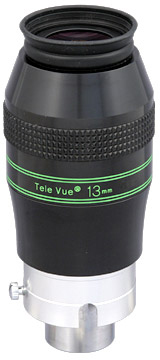 In September 2007 TeleVue Optics released 'Ethos', their newest ultra wide angle eyepiece and an innovative achievement for our astronomy community. Given TeleVue's reputation for innovation and consistently high performance we are not surprised to be enchanted by Ethos. While decades ago eyepieces have been developed that providing similar fields of view, none before delivered the combination of:
In September 2007 TeleVue Optics released 'Ethos', their newest ultra wide angle eyepiece and an innovative achievement for our astronomy community. Given TeleVue's reputation for innovation and consistently high performance we are not surprised to be enchanted by Ethos. While decades ago eyepieces have been developed that providing similar fields of view, none before delivered the combination of:
While Al considered a 100 degree eyepiece concept as far back as 1979, he discarded and forgot about the project. It took David Nagler to really turn the project on. David defined his vision of the eyepiece for long time Tele Vue employee Paul Dellechiaie, who worked out a basic layout. The progress made was enough to convince Al of the projects viability. From that point Paul worked as principal designer under Al's supervision and accomplished the feat. David's insistence on excellence in every technical and functional aspect lead him to choose its name. And by the way, those at TeleVue pronounce it to sound like "Eeethos" not "Ehthos".
Right: Preproduction TeleVue 13mm Ethos Eyepiece. Note the 2 and 1.25 inch nosepieces, and the safety screw for use with optional TeleVue 2/1.25 inch Adapter (25,300 bytes)
Ethos brings deep space home revealing about four (4) times the area of a common 13mm eyepiece! It is designed to let you wade into extended celestial objects and star fields. For those whose telescope does not automatically track objects as the Earth rotates, Ethos can keep objects in the field of view by as much as twice the time that a simple eyepiece can. To take this all in one look straight in and sense the surrounding space with your peripheral vision, or to study any given field area dive right into the eyepiece and literally 'walk' around it to see the entire field of view in detail which means tilting ones head up, down, left and right by as much as forty five degrees to take in the entire view. This is an absolutely breathtaking experience particularly when observing at a very dark site as the crisp stars are contrasted as intense diamonds against the black velour background!
During the initial introduction of the Ethos TeleVue featured a prototype 13mm eyepiece installed onto a TeleVue NP101 telescope, this produced an actual field of view of 2.35 degrees at 42X! The telescope was focused onto a pinpoint artificial star and as observers moved the telescope to position the star across the eyepiece field of view the star appeared as a pinpoint throughout the observing sessions. The wide apparent field of view and clarity throughout it remains even when Ethos is used on very fast focal ratio telescopes (f/5, f4.5, etc.). However, since reflecting telescopes with a comparatively fast focal ratio parabolic primary mirror exhibit coma, Company Seven recommends the use of the optional TeleVue 'Paracor' to attain the best performance.
What can Ethos do with your telescope?
The published 100 degree Apparent Field of View of the Ethos design makes it easy to determine the approximate Actual Field of View that eyepiece will provide on a telescope. This approximation is calculated with a two step process:
-
1. derive the Magnifcation (or X): divide Focal Length of the Telescope by the Focal Length of the Eyepiece
An alternative formula relies on the user knowing the effective Field Stop diameter (22.3mm) of the eyepiece: (57.3 * Field Stop) / Focal Length of Telescope. This formula is more accurate than the simpler method explained above in that it eliminates the added field of view attributable to distortion.
For examples see the following Table:
 TeleVue 85 3.35" 85mm f/7, 600mm FL 46X, 2.1° yes it will look like the tail wagging the Dog, but you will like the view |
 TeleVue NP101 4" 101mm f/5.4, 540mm FL 42X, 2.3° |
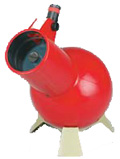 Edmund Astroscan 4.1" 105mm f/4.2, 445mm FL 34X, 2.9° not really manageable on this scope, but would be fun to see! |
TeleVue NP127 5" 127mm f/5.2, 660mm FL 51X, 1.9° |
 Astro-Physics 160EDF 6.3" 160mm f/7.5, 1,200 mm FL 92X, 1.1° |
 Orion XT-10i 10" 250mm f/4.9, 1,250mm FL 97X, 1° |
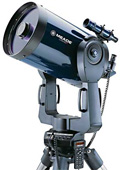 Meade 12" LX-200 12" 298mm f/10, 3,048mm FL 234X, 0.4° |
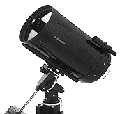 Celestron C-14 14" 355mm f/11, 3,900mm FL 297X, 0.33° |
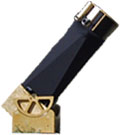 AstroSystems 14½" TeleKit 14.5" 368mm f/5, 1,840mm FL 142X, 0.69° |
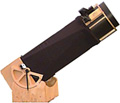 AstroSystems 18" TeleKit 18" 457mm f/5, 2,286mm FL 176X, 0.56° |
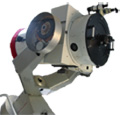 OGS 24" Ritchey-Chrétien 24" - 610mm f/8, 4,880mm FL 375X, 0.26°
or at f/6, 3,658mm FL |
 AstroSystems 25" TeleKit 25" 635mm f/5, 3,150mm FL 239X, 0.41° |
Ethos is compatible with a good quality optional Barlow or TeleVue Powermate Lens (increasing magnification), and with several Telecompressors (decreasing magnification)providing added versatility.
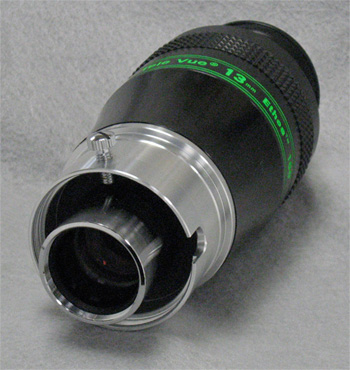
At first glance the 13mm Ethos eyepiece resembles a scaled up and more streamlined version of the original TeleVue 13mm Nagler 82 degree apparent field of view eyepiece that was introduced in 1979. This 653 gr / 23.1 oz behemoth was the first of the high performance ultra wide angle eyepieces in regular production, and Company Seven maintains the last version of the 13mm Nagler alongside the TeleVue 13mm Plossl (50 degree apparent field of view) in our Museum Collection on display. Similarly the 13mm Ethos incorporates a rubber grip ring around its Barrel, with a fold down rubber eyecup as do many of the recent production TeleVue eypieces. But what is amazing to us is how TeleVue has been able to take advantage of new glass and manufacturing technologies to not only make a superior eyepiece, but also to scale the weight of the 13mm Ethos down; even with its dramatic improvements the 13mm Ethos weighs notably less than the 1.44 lb. 13mm Nagler. So while Americans and their eyepieces were getting heavier and heavier, the 13mm Ethos weighing about 1.3 lbs is a pleasant departure from the trend.
Left: 13mm Ethos 2 and 1.25 inch nosepieces with 1.25 Safety Set Screw. Notice the filter and extension threads and the Negative Lens Group (53,366 bytes)
Conceptually similar in arrangement to its Nagler cousins, the Ethos has two components: an ultra wide angle low magnification "eyepiece" mated to a negative group housed in the 1.25 inch diameter Nosepiece. This arrangement provides not only the superb wide field of view, but this also corrects for spherical aberration and other problems that would otherwise appear obvious.
As we do with other similarly configured eyepieces, Company Seven advises its customers to use thread-on 48mm diameter filters for Deep Sky applications and 1.25 filters when observing smaller objects (Planets, Moon). But since a filter added to this nosepiece acts as an extension too, so care must be taken not to "Bottom Out" the nosepiece with a filter attached onto devices such as the TeleVye Paracor, some prism and mirror diagonals.
The 13mm Ethos features the 1.25 and 2 inch barrel arrangement that TeleVue first popularized with the original 13mm Nagler eyepiece, and offers to this day with the 12 mm Nagler Type 4 for example. The 13mm Ethos will accept standard thread in 1.25 inch diameter x 42 tpi (28.5 x 0.6 mm) filters. And as we do for our 12mm Nagler customers, Company Seven will offer an optional thread-on 2 inch diameter Barrel Extension so that the 13mm Ethos may be drawn out on a Focuser as needed to attain focus with telescopes that lack focus travel and this offers the benefit of accepting thread-on 48mm filters. Note most good 2 inch diagonals are also threaded to accept 48mm filters.
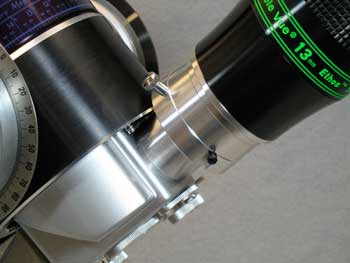 The 13mm Ethos 1.25 and 2 inch barrel arrangement allows the eyepiece to be used attached to a 2 inch focuser by removing the knurled knob that is provided threaded into the 2 inch aluminum barrel. But for use in 1.25 inch focusers it is recommended to use not only the knurled knob on the 2 inch barrel to apply pressure to the focuser eyepiece holder, but also use the 1.25 inch focuser set screw too; the 2 inch barrel of the 13mm Ethos is provided with a cut away to accommodate most focuser set screws.
The 13mm Ethos 1.25 and 2 inch barrel arrangement allows the eyepiece to be used attached to a 2 inch focuser by removing the knurled knob that is provided threaded into the 2 inch aluminum barrel. But for use in 1.25 inch focusers it is recommended to use not only the knurled knob on the 2 inch barrel to apply pressure to the focuser eyepiece holder, but also use the 1.25 inch focuser set screw too; the 2 inch barrel of the 13mm Ethos is provided with a cut away to accommodate most focuser set screws.
Right: 13mm Ethos on a Questar 3-½ Duplex telescope, note how this is secured by both the eyepiece and telescope focuser set screws (14,529 bytes)
Click on image to see enlarged view (29,027 bytes).
-
How Does It Compare?
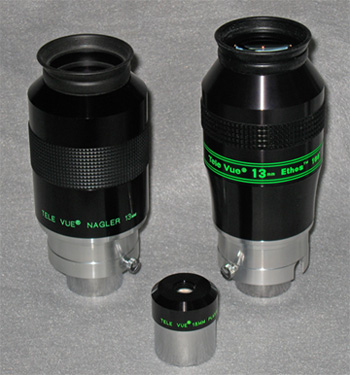
The overall perfection of the rendered images are superior in the Ethos than in its predecessors. In terms of contrast, and definition to the edges of the field of view, and reduction of distortion too the Ethos beats the original 13mm Nagler and the old 12mm Nagler Type 2 for sure. As Al Nagler noted:
"For reference, the maximum angular magnification distortion of the new 13mm Ethos is no more than 1% at any point in the 100° field"
A criticism of the original 13mm Nagler eyepiece that we felt was valid involved the occasional appearance of subtle ghost image that could be produced when light from an off axis intense star reflected back and forth between the surfaces within the Nagler eyepiece. The dramatic improvements in antireflection coatings over the past decade have eliminated the ghost images that could at times be seen in some older designs, so in the Ethos this is not a concern. These new coatings also increase the contrast so subtle details become more obvious.
Right: 13mm Ethos with discontinued TeleVue 13mm Nagler and 13mm Plossl eyepieces in Company Seven's collection (49,035 bytes)
Click on image to see enlarged view (141,208 bytes)
The design is scaled to provide eye relief (designed distance between the Eye Lens and the Eye of the user) of 1.15x the focal length so the eye relief of the Ethos is 15mm. And for those observers with astigmatism, Ethos accepts the optional DIOPTRX™ Eyesight Astigmatism Correction Lens; another unrivaled innovation from Al Nagler.
On paper one alternative to the Ethos is TeleVue's 13mm Nagler Type 6, this is one of the a compact series of 82 degree eyepieces and with a 1.25 inch barrel. While an impressive achievement particularly when placed alongside the original 13mm Nagler, the Type 6 are not as well corrected for distortion as the Nagler Type 4 or the Ethos. The Type 6 can make sense for those on a constrained budget, for use with binocular viewers, or for use with telescope that may not manage the mass of the larger eyepieces. But starting with those 13mm Ethos made in March 2008 and later, the barrel diameter is milled to be narrower by 1/16 inch (1.5 mm) so that customers using this eyepiece on the TeleVue Bino View can achieve an interpupilary spacing as minimal as 62 mm.
In terms of comparing it against production eyepieces the closest to the Ethos is the TeleVue 12mm Nagler Type 4, a third generation 82 degree ultra wide angle Nagler design weighing 16.3 oz / 462 g. There really are no other ultra wide angle eyepieces in this class even though some alternatives are sold for notably higher costs. The 12mm Nagler Type 4 is a striking eyepiece well known in the community as the shortest member of the Nagler Type 4 series with the others being the similarly successful 17mm and 22mm Nagler eyepieces both with 2 inch diameter barrels. Of course both the 12mm Nagler Type 4 and the 13mm Ethos ultra wide angle eyepieces dwarf the more common three or four element 1.25 inch diameter eyepieces since even the best of these such as our Astro-Physics 12mm Super Planetary weigh only 3.2 oz / 92 gr.
It is possible that TeleVue will offer 2 inch diameter versions of Ethos eyepieces in longer focal lengths. Making some basic assumptions and without yet having tested the new Ethos to determine its degree of distortion (all production wide angle eyepieces exhibit this effect this to some degree or another), we can guess the 13mm Ethos design will show 1.49X the area of a similar focal length Nagler series eyepiece, or a bit wider true field of view than the 16mm Nagler Type 5. It will show 2.16 times the area of a similar focal length Panoptic (if there were one of course), and four times the area of a Plössl. With a typical good quality 26mm Plössl having a Field Stop on the order of 22mm diameter, the 13mm Ethos has an effective Field Stop so large that one will see about the same actual field of view as one would see with a 26mm Plössl but at TWICE THE MAGNIFICATION! Just imagine seeing the full Moon at 156x in an 20 inch f/4.8 Dobsonian - with a true field of view of 0.52 Degrees. The possibilities for what we might see with longer focal length versions of Ethos stir the imagination!
Initially announced on 28 April in 13mm focal length other focal lengths will almost certainly follow. Of course, Company Seven was among the first in the world to show the eyepiece and have them in stock and you can count on us to have the next if and when TeleVue decides to give us all another "fix". Feel free to contact Company Seven for additional details or to place an order.
Company Seven began making deliveries of the first Ethos in September 2007 - and of course Martin now has his. Soon we intend to post articles regarding viewing experiences with the Ethos, so stay tuned to our latest news page for these announcements.
13mm ETHOS™ SPECIFICATIONS (March 2008):
| Focal Length: | 13mm |
| Apparent Field of View: | 100 Degrees |
| Eye Relief: | 15mm (0.59") |
| Eye Lens Diameter: | 29.18mm (1.15") |
| Field Stop Diameter: | 48.93mm (1.93") |
| Effective Field Stop Diameter: | 22.3mm (0.88") |
| Anti-Reflection Coatings: | Air-spaced elements are fully Multicoated |
| Height: | 144.8mm (5.78") with Eyecup folded down |
| Barrel Max. Diameter: | 62.06mm (2.44") |
| Outer Nosepiece Diameter: | 50.79mm (2.0") |
| Inner Nosepiece Diameter: | 31.63mm (1.25") |
| Inner Nosepiece Filter Thread: | 1.25 inch diameter x 42 tpi (28.5 x 0.6 mm) |
| Weight: | 20.8 Oz / 591 gr. (1.3 lbs) |
| Origin: | ROC Taiwan |
* Specifications are subject to change without notice.
Contents Copyright 2008 Company Seven, All Rights Reserved

